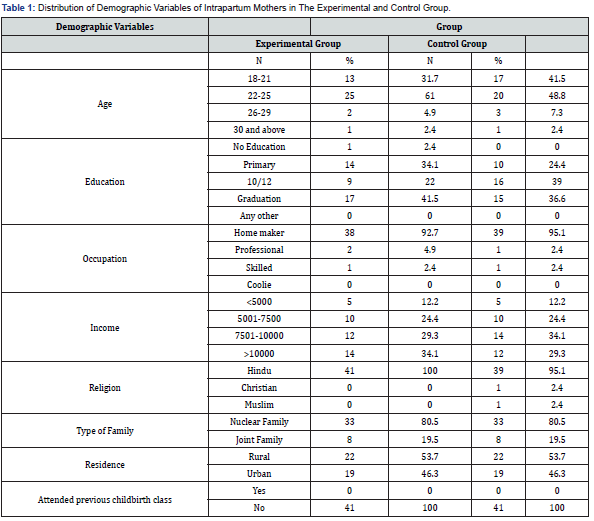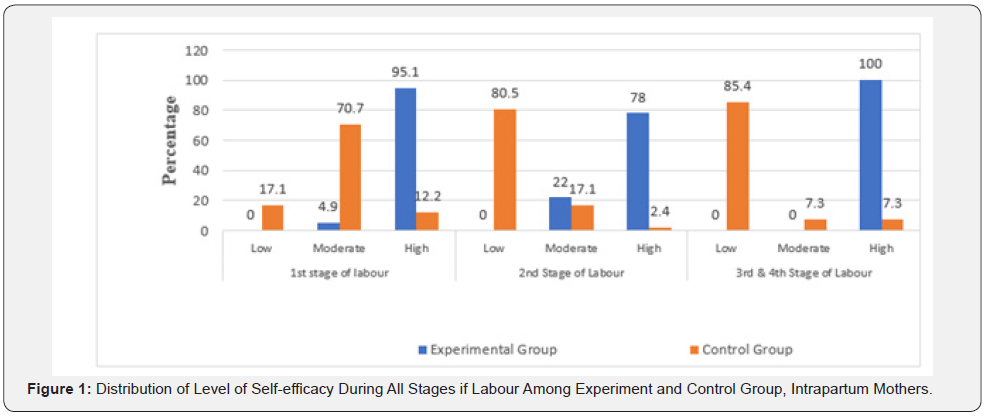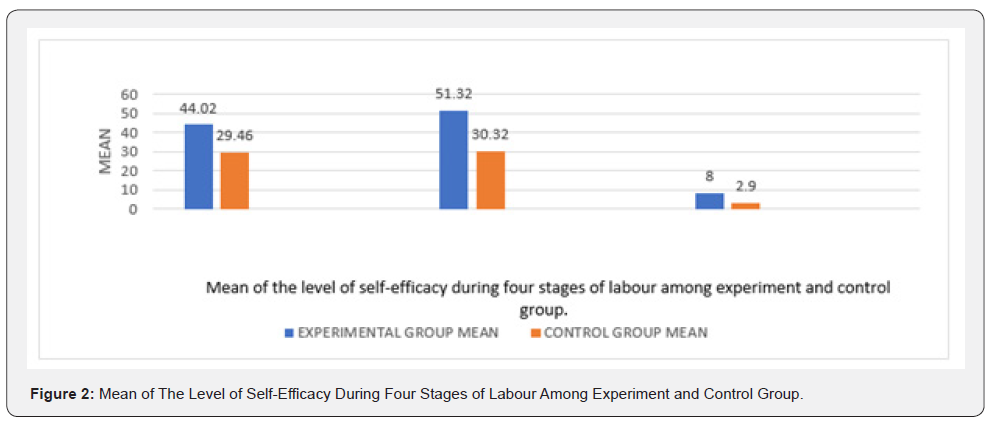Juniper Online Journal of Public Health - Juniper Publishers
Abstract
Background: Becoming mother is the awesome feel and greatest gift for the women in her aliveness. Over 90% of antenatal pressure and anxiety is associated to the development of childbearing. Mother’s anxiety in this duration frequently is due to the lack of information and antenatal fear of the unidentified risks and childbirth. Stimulation of antenatal knowledge and ability makes mothers for delivery and augment their health.
Aim: To evaluate the effectiveness of prenatal self-efficacy enhancing educational programme on maternal self-efficacy during intrapartum period.
Subjects and Methods: The Quantitative Quasi-experimental (post-test only control group) design was used among prenatal mothers in selected hospital at Puducherry. Sample size was 82, selected by purposive sampling technique. Data collection was done with the self- administered questionnaire. It has three sections. Section A: Demographic and obstetric variables, Section B: Modified Nancy Standardised Likert scale for estimation of self-efficacy during first and second stage and Section C: Self-Efficacy Expectancy Checklist on third and fourth stage of labour.
Results: The major findings of the study showed that in the experiment group, the majority 39 (95.1%) mothers had high level of self-efficacy in first stage of labour, 32 (78%) mothers had high level of self-efficacy in second stage of labour and 41 (100%) mothers had high level of self-efficacy in third and fourth stage of labour. Whereas in the control group, majority 29 (70.7%) mothers had moderate level of self-efficacy during first stage of labour, 33 (80.5%) mothers had low level of self-efficacy in second stage of labour and 35 (85.4%) mothers who had moderate level of self-efficacy during third and fourth stage of labour. So, the level of self-efficacy had enhanced with experimental group than control group mothers.
Conclusion: The study results highlighted and proved statistically (p<0.001) that Prenatal Self-Efficacy Enhancing Educational Program was found to be effective in reducing fear and enhance individual’s self-efficacy during intrapartum period through the difference in the level of self-efficacy among experiment and control group which ultimately reduces caesarean section and indirectly decreasing morbidity and mortality rate.
Keywords: Antenatal self-efficacy enhancing programme; Antenatal education; Self-confidence; Intranatal period
Introduction
Every woman wants to become a queen at one stage without any restriction. It is the valuable event for the couple to get the future as parents. It is not about how often a woman gives birth, each pregnancy and delivery are unique and intimate experience in life. Childbirth is a multi-faceted task with physical, emotional, social, physiological, cultural and mental dimensions, which is reflect on a critical experience in every woman’s life [1]. Gestation takes about a great many variations in somatic, emotional and social aspects of life. First-time mothers have the added stressors of adopting to their new role as mothers and the uncertainties connected with their capacity to nurture a new-born for the first time, hence many women-if they have such the possibility-decide to contribute in childbirth education classes. The originator of the idea, Grantly Dick-Read. A British Obstetrician was the first one to perceive an association between the psychological state of the woman in labour and the pain which accompanies childbearing. He defined that association as the fear-tension-pain syndrome, which was the cause of pain during labour [2,3].
Self-efficacy, viewed as an essential concept in nursing care because it focuses the importance of authorising the patient., as well as self-management [4]. According to Bandura, the faith in one’s ability to cope with a specific task affects the hard work invested in accomplishing the task. High self-efficacy levels encourage the investment of considerable efforts toward achieving goals and regulate the degree of effort and amount of time to be invested in carry out the task in order to overcome the difficulties [5]. As a consequence of fear and anxiety, discharge of stress hormones rises and can lead to preterm birth, lack of progress, low birth weight of the child and fear hypoxia [6]. Women’s access to all health services, along with increased awareness through education and counselling during pregnancy and childbirth are captious effective factors in the anticipation from mortality and stumbling block in this stage. Stimulation of antenatal knowledge and ability makes mothers for delivery and augment their health [7]. In many portions of the Earth, Antenatal and delivery drills that educate expectant women and their partners about labour and parenthood is habitually provided for females as part of antenatal care [8].
Objectives
a) To assess the level of Self-Efficacy after Prenatal Self- Efficacy Enhancing Educational Programme (SEEEP) among Experimental group mothers during Intrapartum period.
b) To assess the level of Self-Efficacy among Control group mothers during Intrapartum period.
c) To evaluate the effectiveness of Prenatal Self-Efficacy Enhancing Educational Programme (SEEEP) on maternal Self-Efficacy between the experimental group and the control group mothers during Intrapartum period.
d) To associate the level of Self-Efficacy with the selected demographic and obstetrical variables among the experimental group mothers.
Methodology
Research methodology is the fundamental procedure for conducting the study. In order to achieve the objectives, a quantitative research approach was found to be appropriate. Research design used for this study was a quasi-experimental post-test only with control group design and research variables were maternal self-efficacy and prenatal Self-Efficacy Enhancing Educational Programme. The study was conducted in Rajiv Gandhi Government Women and Children hospital, Puducherry. The population belonging to the prenatal mothers who were admitted in antenatal ward with inclusion criteria. The researcher had selected 90 Primigravidae and Nulliparas who fulfilled the inclusion criteria as samples for this study. Among them 8 subjects were become dropouts due to caesarean section and with that 2 were from experiment group and 6 were from control group.
The sample size was comprised of 82 (41 in experiment and 41 in control group) mothers. Sampling technique was used in this study was purposive sampling technique. Inclusion criteria of sample were Primigravidae and Nullipara mothers [1] Between 39- and 42-weeks’ gestation admitted in antenatal ward [2] Admitted for safe confinement [3] Willing to participate [4] Present during data collection [5,6] Able to understand Tamil and English language. The tool description was divided into three sections. Section A: This section contained of Demographic and Obstetric variable profile include age, education, occupation, income, religion, residence, type of family, gestational age, parity, present health condition and duration of labour. Section B: This section contained statements on Level of self-efficacy during first and second stage was assessed using modified Nancy selfefficacy inventory observational questionnaire. It has two parts. Part 1 deals with self-efficacy for first stage of labour, it was a five-point Likert scale containing 10 items describing about the childbirth experiences, out of which 4 items have got direct scoring and 6 items have got reverse scoring [6-10].
The scoring of each items implies: 1- Almost all the time, 2- A lot but not always, 3- About half the time, 4- Sometimes, 5- Never or almost never. The total score was between 10 and 50. Level of Self-Efficacy during First stage of labour was scored as Low 10-20, Moderate 21-30, High 31-50. Part 2 deals with Self-Efficacy expectancy for second stage of labour, it was a numerical rating scale containing 10 items with score for each item ranging from 1-5, describing the behavioural expectancies during second stage of labour. Level of Self-Efficacy during Second stage of labour was scored as Low 10-20, Moderate 21- 30, High 31-50. Section C: This section contained researcher made checklist assessing third and fourth stage self-efficacy. it was prepared by the researcher containing 8 items which were expected after birth of the child. Among them 4 items have got direct scoring and 4 items have got reverse scoring. Score of 1 will be given if they perform and no score was given if not performed (direct scoring). Score of 1 will be given if they not perform and no score was given if performed (reverse scoring). Level of Self-Efficacy during Third and fourth stage of labour was scored as Low 0-2, Moderate 3-5, High 6-8. After completion of pilot study, the researcher conducted the study from 27/8/2018 to 22/9/2018 at Rajiv Gandhi Government Women and Children Hospital, Puducherry. Investigator obtained a formal permission from institutional ethical committee for conducting the study. The researcher introduced herself to the mothers. The purpose of the study clearly stated to the mothers. Informed consent was obtained from each mother in both oral and written form. The mothers had the freedom to withdraw from the study at any time.
On each day, around 2-3 mothers were selected for educational intervention for 45 minutes which consisted of stages of labour, pre-preparation for labour, procedures carried out in labour room, physiological changes and care during all stages of labour and data were collected by using modified standardised structured questionnaire on level of self-efficacy among mothers. The same mothers were followed up and observed during their second third and fourth stage of labour using modified standardised structured questionnaire [11-16].
Results
The results showed that in the experiment group, majority 25 (61%) mothers were in the age group of 22-25 years, 17 (41.5%) mothers had Graduation in education, 38 (92.7%) mothers were homemakers, 14 (34.1%) mothers were belonged to monthly income more than Rs. 10000, 41 (100%) mothers were Hindu, 33 (80.5%) mothers were lived in nuclear family, 22 (53.7%) mothers were in Rural residence, 41 (100%) mothers were not attended childbirth preparation class. Whereas in the control group, majority 20 (48.8%) mothers were in the age group of 22-25 years, 16 (39%) mothers had completed higher education, 39 (95.1%) mothers were homemakers, 14 (34.1%) mothers were belonged to monthly income between7500-10000, 39 (95.1%) mothers were belonged to Hindu, 33 (80.5%) mothers were lived in nuclear family, 22 (53.7%) mothers were in Rural residence, 41 (100%) mothers were not attended childbirth preparation class (Table 1).

The results predicted that in the experimental group, Majority 39 (95.1%) mothers had high level of self-efficacy when compared to control group 29 (70.7%) mothers who had moderate level of self-efficacy during first stage of labour.During second stage of labour, 32 (78%) mothers had high level of self-efficacy in experimental group and 33 (80.5%) mothers had low level of self-efficacy. During third and fourth stage of labour, 41 (100%) mothers who had high level of self-efficacy in experimental group when compared with control group 35 (85.4%) mothers had moderate level of self-efficacy. So, the level of self-efficacy had increased with experimental group than control group mothers (Figure 1).

The results depicted that in the experiment group, the mean score of self-Efficacy during latent phase of labour was 44.02±3.182. The mean score of self-Efficacy during second stage of labour was 51.32±11.844 and the mean score of self- Efficacy during third and fourth stage of labour was 8.00±0.000. The total self-efficacy among experimental group was found with the significance of t=20.088 (sig=0.000). Whereas with the control group, the mean score of self-Efficacy during latent phase of labour was 29.46±6.705. The mean score of self-Efficacy during second stage of labour was 30.32±19.508 and the mean score of self-Efficacy during third and fourth stage of labour was 2.49±1.625. The total self-efficacy among experimental group was found with the significance of t=20.088 (sig=0.000) (Figure 2).

Discussion
The discussion of the study was positioned on the findings from the statistical analysis of assessment of level of self-efficacy between experiment and control group intrapartum mothers. It was showed clearly that there was a significant difference in the level of self-efficacy among experimental mothers than the control group mothers. Therefore, it was implied that the experimental group mothers’ level of self-efficacy was improved, and it was statistically proved. The present study was supported by authors said that the core relationship was examined by Lowe between perception of self-efficacy in coping with childbirth and the fears related to childbirth among nulliparous women. She found an inverse relationship between the levels of self-efficacy and the levels of fear related to childbirth.
Similar results were also observed in the studies conducted by Reck & Beebe. who found a significant positive correlation between the overall anxiety level and birth related anxiety, a significant negative correlation between the anxiety level and self-efficacy level in coping with child birth and a significant negative correlation between ways of coping with the child birth process in the study of the Effect of childbirth preparation courses on anxiety and self-efficacy in coping with childbirth. The study was supported by the study conducted by David Yohai found significantly shorter duration during entire duration of labour (p=0.026) in the study of effect of attending a prenatal childbirth preparedness course on labour duration and outcomes. The study was supported by the study conducted by Gozde Gokce Isbir found improved self-efficacy with imparting antenatal education with highly significant (p<0.05) in study of the effects of antenatal education on fear of childbirth, maternal self-efficacy and post-traumatic stress disorder symptoms following childbirth.
Conclusion
The above study results highlighted and proved statistically that Prenatal Self-Efficacy Enhancing Educational Program was found to be effective in reducing fear and enhance individual’s self-efficacy during intrapartum period through the difference in the level of self-efficacy among experiment and control group which ultimately reduces caesarean section and indirectly reducing morbidity and mortality rate of mothers. So, this method of teaching programme on self-efficacy among the intrapartum mothers can be promoted in prenatally by nurse in their day to day activities in hospital settings.
To Know more about Juniper Online Journal of Public Health
Click here: https://juniperpublishers.com/index.php





No comments:
Post a Comment